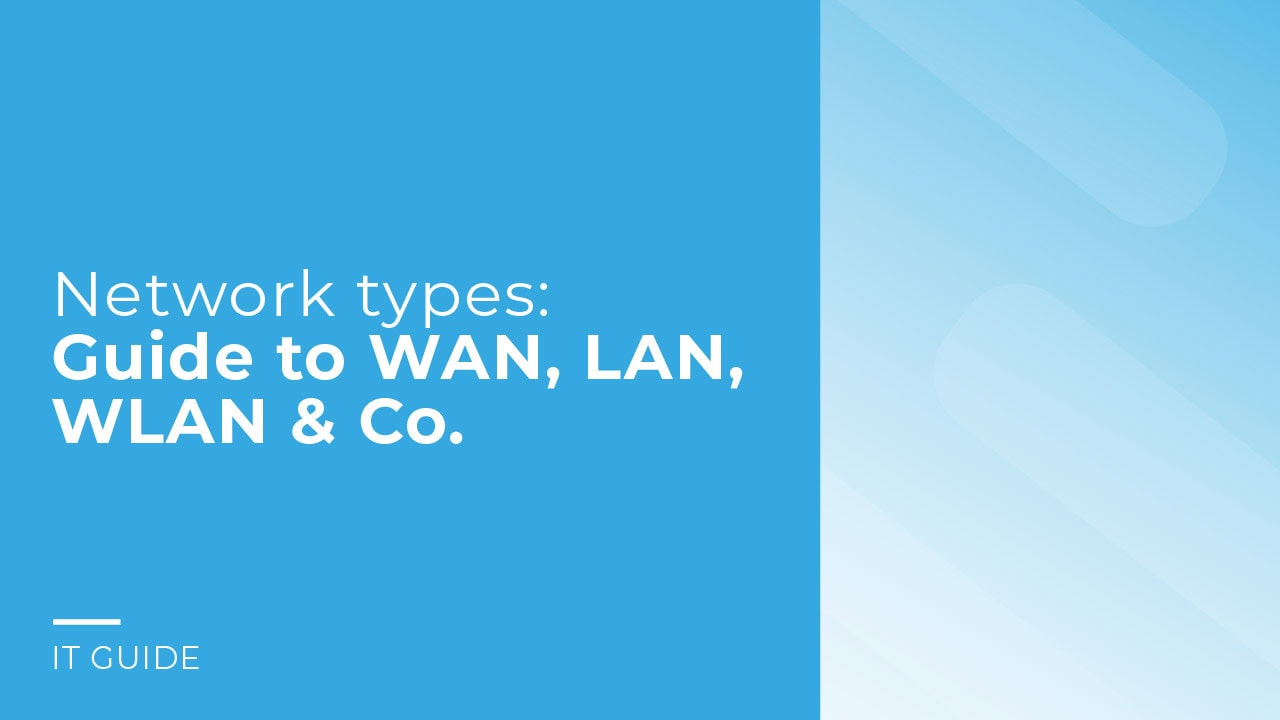
An IT network is the combination of independent computer systems that exchange information and share resources via cables or wireless connections. A network connects several computer systems physically and logically and forms the basis for data transmission and collaboration. IT networks are crucial for digitalization, big data and hybrid work, optimize work processes and improve IT efficiency in companies. Find out how you can efficiently expand your company's IT infrastructure in our blog post "Build IT infrastructure and benefit from improved processes". Networks follow different technologies and standards, from simple peer-to-peer networks to complex client-server networks. This blog post provides a comprehensive overview of different network types to give you an in-depth understanding of their features and benefits.

WAN stands for "Wide Area Network" and is a comprehensive computer network that connects different locations over large distances. This network type plays a key role in global communication structures as it can cover large geographical areas (countries or continents) and is not limited to local areas.
Transmission protocols and address concepts support the exchange of data. WANs use technologies such as IP/MPLS, PDH, SDH and more to establish these connections. In large companies, WANs are often used to connect office networks. Each office has its own local area network (LAN), which is networked together via WANs. IP tunnels or virtual private networks (VPN) are used to implement long connections. Switches, routers and network nodes are crucial for data transmission in WANs, where transmission rates are higher than in LANs. Wireless variants such as the Wireless Wide Area Network (WWAN) are also widespread.
Advantages of WANs:
WANs are crucial for companies that use digital resources to enable communication, data access and application hosting. Companies use different connection types such as leased lines, tunneling, Ethernet and SD-WAN to connect sites, data centers and cloud resources. Our blog post "Efficient power supply via Ethernet or InfiniBand" provides detailed information on Ethernet.

LAN stands for "Local Area Network" and refers to a network that is restricted to a limited spatial area. It usually extends within a building or via a data center. In a LAN, end devices communicate and interact with each other and use the services provided. LANs are used in companies, educational institutions and home networks, as they enable fast and efficient data exchange between the connected devices.
A wide variety of devices can be connected in a LAN, including laptops, servers, printers and IoT devices. Large LANs can include a high number of several thousand devices. If more than two computers are connected in a local network, additional network components such as hubs, bridges and switches are required. These act as connectors and distribution nodes. Twisted pair cables are normally used for LAN cabling. In professional environments and for higher bandwidths, fiber optic connections are often used.
Compared to metropolitan area networks (MAN), however, LANs are smaller. Multiple of these network types can be connected via IP tunnels or VPNs to form larger networks, with the Internet being an example of a collection of LANs connected via WAN links.
A large number of LANs are connected to the Internet via a central point - the router. A single router is often used in private home LANs, while network switches can also be used in more extensive LANs to enable more efficient forwarding of data packets. LANs are usually connected via the common Ethernet standard, although wireless connections such as WLAN are also possible. Virtual LANs, or VLANs for short, also offer the option of dividing data traffic on a shared physical network into two separate networks.

WLAN stands for "Wireless Local Area Network" and is a wireless network used in limited geographical areas such as homes, offices, businesses or educational institutions. It enables wireless communication between devices, including computers and smartphones, to provide access to the internet or local network resources. To make this possible, the end devices must be connected to the WLAN router, the central component of the WLAN network. To ensure data security against unauthorized access, WLAN connections are usually encrypted. Various encryption methods are available, such as WPA or WEP.
Advantages of WLANs:
WLANs are based on the IEEE 802.11 standard, which uses wireless technologies. Wireless access points (WAPs) provide the wireless signals and manage the data traffic. WLANs use network nodes that communicate with each other via network cards, with each network node representing a separate radio cell. Data transfer rates can theoretically vary between 2 and 600 megabits per second, with practical limitations due to interference and obstructions.

VLAN stands for "Virtual Local Area Network" and represents a virtual sub-network within a physical Local Area Network (LAN). This network type is used to divide the LAN into logical segments and create separate broadcast domains for each of these segments. VLANs are usually implemented using managed switches. The creation of an individual broadcast domain for each VLAN enables the transmission of broadcasts and data packets.
Advantages of VLANs:
There are different types of VLANs, with port-based and tagged VLANs being the most common. With port-based VLANs, logical segmentation is achieved by assigning individual ports to a specific VLAN. In contrast, tagged VLANs operate at the frame level, where a "tag" within the message frame is responsible for the assignment. This structure facilitates a flexible and clear organization, especially in business environments.

CAN stands for "Campus Area Network" and is a local computer network that exists within a limited geographical area such as a company site or a hospital complex. This network links several local area networks (LANs) together and extends over a range of up to 5 km. Compared to wide area networks (WANs) and metropolitan area networks (MANs), a CAN is smaller in size.
The main function of a CAN is to enable seamless communication and the exchange of data and resources for users. A characteristic feature of the CAN is the high speed of data transmission, which is constant and faster than the Internet speed. Ideally, all nodes in a campus network are connected to each other via fiber optic cables and benefit from the possibilities of Gigabit Ethernet or 10 Gigabit Ethernet technology.
Advantages of CANs:
Applying security policies to the entire network is easier for IT teams compared to if the campus had multiple separately managed networks. An example of the use of a CAN can be found in universities, where it connects the management of academic buildings, libraries and other facilities.

GAN stands for "Global Area Network" and describes far-reaching computer networks that operate across geographical distances. They connect different wide area networks (WANs) and combine elements of WANs and local area networks (LANs).
International companies use GANs to network their globally distributed locations, exchange data and enable communication between users. They use fiber optic infrastructure and connect WANs via international satellite transmission or submarine cables. GANs are used in business collaborations, conference calls, online gaming, file sharing and remote database access.
Advantages of GANs:
The Internet itself is an example of a GAN, but companies also operate private GANs that are isolated from the public Internet. The transmission speed on a GAN channel is usually 2 Mbit/s.

MAN stands for "Metropolitan Area Networks" and describes a network that connects users in a specific geographical area. The range of a MAN extends over a larger area than a Local Area Network (LAN), but not as far as a Wide Area Network (WAN). This geographical area can include a single large city, several cities, municipalities or a collection of buildings.
In a MAN, different local area networks (LANs) are connected to each other by fiber optics and are more efficient than wide area networks (WANs) because data transmission covers shorter distances. Wireless variants such as Wireless Metropolitan Area Networks (WMANs) can use WiMAX technologies, which makes it possible to set up WLAN hot zones.
Advantages of MANs:
The main objective of a MAN is to enable fast and reliable communication between different locations within a city or metropolis. The transmission speeds in MANs are comparable to the internal communication of a LAN and can be optimized using specialized transmission technologies such as Metro Ethernet.

PAN stands for "Personal Area Network" and is a network infrastructure that aims to connect devices in the immediate vicinity of a user. This is a special network type developed for data exchange and the connection of small devices without the need for an extensive network infrastructure.
Essentially, a PAN enables wireless or wired communication between digital devices located within a limited physical area of about ten meters or less. This includes devices such as laptops, smartphones, tablets and other wireless peripherals. Wired communication is achieved through common transmission methods such as USB or FireWire. To establish wireless communication (Wireless PAN), various transmission technologies are used, including Bluetooth, infrared, WLAN and other wireless protocols. Unlike larger networks such as LANs or WANs, a PAN does not require a router or extensive network infrastructure.
Advantages of PANs:
The applications of a PAN are diverse and range from connecting peripheral devices such as keyboards and mice to a computer to exchanging data between mobile devices.

VPN stands for "Virtual Private Network" and is a technology that establishes protected and encrypted connections via private or public networks to ensure the privacy, security and confidentiality of data communication in insecure networks. Encryption technologies are used in the transmission of data packets to protect sensitive information from unauthorized access. The use of VPNs also makes it possible to hide the user's true IP address and bypass geographical restrictions.
VPNs are used in various areas, such as in public applications (such as apps or websites), companies or private applications. A VPN forms a closed, private virtual IT network between a VPN client and a VPN server via public networks such as the Internet. These networks are often used for remote work or in the home office.
Advantages of VPNs:
There are different types of VPN connections, including client-to-site VPN, site-to-site VPN and end-to-end VPN. A VPN uses the public Internet as a transport medium, whereby the data is transmitted within a virtual "tunnel" between the VPN client and the VPN server. As a rule, the transmitted and received data is encrypted end-to-end.
It is important to emphasize that VPNs should not be equated with the encrypted transmission protocol HTTPS. HTTPS ensures the confidentiality of communication between a web server and a web browser on the World Wide Web, while VPN encrypts data communication between two endpoints. This means that VPN also offers protection when an app is used instead of a browser. You can find out more about VPN in our blog post "VPN: secure network access from a distance".
| Aspects | Range | Connection | Use |
|---|---|---|---|
| WAN | Over large geographical distances, often globally | Uses public or private communication lines | Connects different locations, countries, continents |
| LAN | Local, limited to one building or data center | Wired (Ethernet) or wireless (Wi-Fi) | Local office networks, home networks |
| WLAN | Local, typically up to 100 meters | Wireless technologies such as Wi-Fi | Offices, apartments, campus |
| VLAN | Over long geographical distances within a local network | Wired or wireless possible | Organization of networks based on departments, functions or security requirements |
| CAN | Local, limited to a university or company campus | Special protocol for communication between control units, e.g. Ethernet or fiber optics | University campuses, company premises or research centers |
| GAN | Worldwide | Uses WAN technologies across different continents | Global corporate networks, organizations or data centers (worldwide) |
| MAN | City or large urban area | Various technologies such as Ethernet | Urban networks |
| PAN | Very local, within a few meters | Short-range connections such as Bluetooth, but also wired connections such as USB | Connection of personal devices, e.g. smartphone with headphones |
| VPN | Can be local or global, depending on the endpoints | Secure connection via the insecure Internet (wireless) | Secure remote access, connection from remote locations |
Overall, the different network types, from WAN to LAN to VPN, illustrate the variety of possibilities for modern communication and data transmission. Each network type offers specific advantages that vary depending on the usage scenarios of companies and private users.
The network types therefore play a decisive role in the efficiency, security and scalability of the network infrastructure. For more security in your company, you can read our article "IT security in companies: Importance and solutions" to learn about basic security measures to strengthen security in your company.